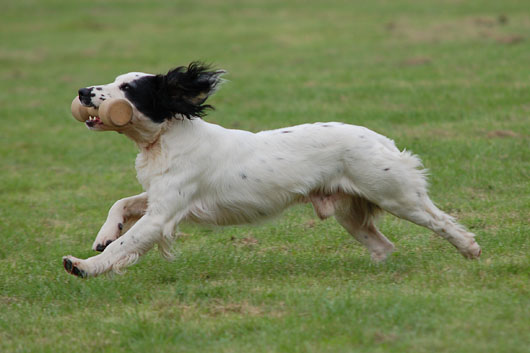We now have a cosmetic layer of snow that brings the right Christmas spirit, but still allows us to train herding in the big field and take walks in the woods. Perfect! We’ve been doing a few hours herding and then a couple of hours of agility and obedience in the riding facility every day. In the blog today, I thought I’d write about how our dogs innate behaviors can give us challenges in training. One might think that the retrieve would be easier to teach a retrieving breed, but we’ve found that it’s not like that at all. Teaching our cockers a nice retrieve for obedience has proven to be a great challenge. Shejpa doesn’t do competitive obedience (if you ask her, she doesn’t do any obedience at all…) so I haven’t put much work into it, but Thomas has worked a lot with Pogue.

Pogue is a natural retriever and loves to carry things around. His natural reaction is to carefully pack objects in his mouth, then trot around in circles with them. Both things are not very good for obedience, where we want the dog to grip fast, hold hard and run fast. Even though Pogue knows these things when working on the details, it’s often much worse when the behaviors are performed in a sequence. It’s a constant struggle to get him to not fall back on what he was bred to do.
Thomas has never cared much about what Pogue does once he gets a toy. He’s been happy to let Pogue trot around with his toys between repetitions in training. But then he realized that Pogue was actually repeating the behavior he doesn’t want in retrieving over and over again. 95% of the time when Pogue picked up an object in training, he was allowed to have fun on his own with it and the behavior got even stronger. When Thomas realized this, he started to look at all these situations as an opportunity to build a new habit. Every time Pogue got his toy, Thomas would give a verbal cue (“ja!”) and throw a new toy or a big piece of food the other way. Pogue soon begun to expect the new reward and started to turn to Thomas when he grabbed his toy. This required a new kind of concentration from Thomas, who was used to leaving Pogue on his own between repetitions, but made a big difference to the retrieve in obedience.
You can find many examples like these in training – like doing loads of circle work to keep your border collie from flanking, then disconnecting from him between repetitions in agility training, not noticing that he is flanking you all the way back to the start line. It might not seem like a big deal, but these innate behaviors do not need to be rehearsed much since they are so natural and so reinforcing to the dog. If you allow them to happen a lot outside of training (or even in training, like the two examples above), they might be hard to get rid of when you don’t want them in training. With my border collies, I don’t ever need or want flanking and eyeing in training, so I never allow it to happen. And I’m happy to report that a lot of herding does not seem to make them more likely to show it when there isn’t any sheep around.



Leave a comment